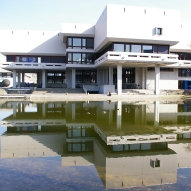| Dokumentenart: | Artikel | ||||
|---|---|---|---|---|---|
| Titel eines Journals oder einer Zeitschrift: | Radiation Research | ||||
| Verlag: | RADIATION RESEARCH SOC | ||||
| Ort der Veröffentlichung: | LAWRENCE | ||||
| Band: | 195 | ||||
| Nummer des Zeitschriftenheftes oder des Kapitels: | 1 | ||||
| Datum: | 2020 | ||||
| Institutionen: | Medizin > Lehrstuhl für Röntgendiagnostik | ||||
| Identifikationsnummer: |
| ||||
| Stichwörter / Keywords: | PANTHER; CANCER; CARCINOGENESIS; SURVIVAL | ||||
| Dewey-Dezimal-Klassifikation: | 600 Technik, Medizin, angewandte Wissenschaften > 610 Medizin | ||||
| Status: | Veröffentlicht | ||||
| Begutachtet: | Ja, diese Version wurde begutachtet | ||||
| An der Universität Regensburg entstanden: | Ja | ||||
| Dokumenten-ID: | 56158 |
 Web of Science
Web of ScienceZusammenfassung
Radiosensitivity differs in humans and likely among closely-related primates. Reasons for variation in radiosensitivity are not well known. We examined preirradiation gene expression in peripheral blood among male and female rhesus macaques which did or did not survive (up to 60 days) after whole-body irradiation with 700 cGy (LD66/60). RNA samples originated from a blinded randomized Good ...

Zusammenfassung
Radiosensitivity differs in humans and likely among closely-related primates. Reasons for variation in radiosensitivity are not well known. We examined preirradiation gene expression in peripheral blood among male and female rhesus macaques which did or did not survive (up to 60 days) after whole-body irradiation with 700 cGy (LD66/60). RNA samples originated from a blinded randomized Good Laboratory Practice study in 142 irradiated rhesus macaques. Animals were untreated (placebo), or treated using recombinant human IL-12, G-CSF or combination of the two. We evaluated gene expression in a two-phase study design where phase I was a whole genome screen [next generation sequencing (NGS)] for mRNAs (RNA-seq) using five RNA samples from untreated male and female animals per group of survivor and non-survivor (total n = 20). Differential gene expression (DGE) was defined as a statistically significant and >= 2-fold up- or downregulation of mRNA species and was calculated between groups of survivors and non-survivors (reference) and by gender. Altogether 659 genes were identified, but the overlapping number of differentially expressed genes (DGE) observed in both genders was small (n = 36). Fifty-eight candidate mRNAs were chosen for independent validation in phase II using the remaining samples (n = 122) evaluated with qRT-PCR. Among the 58 candidates, 16 were of significance or borderline significance (t test) by DGE. Univariate and multivariate logistic regression analysis and receiver operating characteristic (ROC) curve analysis further refined and identified the most outstanding validated genes and gene combinations. For untreated male macaques, we identified EPX (P = 0.005, ROC=1.0), IGF2BP1 (P = 0.05, ROC=0.74) and the combination of EPX with SLC22A4 (P = 0.03, ROC=0.85) which appeared most predictive for the clinical outcome for treated and combined (untreated and treated) male macaque groups, respectively. For untreated, treated and both combined female macaque groups the same gene (MBOAT4, P = 0.0004, ROC = 0.81) was most predictive. Based on the probability function of the ROC curves, up to 74% of preirradiation RNA measurements predicted survival with a positive and negative predictive value ranging between 85-100% and associated odds ratios reflecting a 2-3-fold elevated risk for surviving per unit change (cycle threshold value) in gene expression. In conclusion, we identified gender-dependent genes and gene combinations in preirradiation blood samples for survival prediction after irradiation in rhesus macaques. (C) 2021 by Radiation Research Society
Metadaten zuletzt geändert: 29 Feb 2024 12:26



 Altmetric
Altmetric